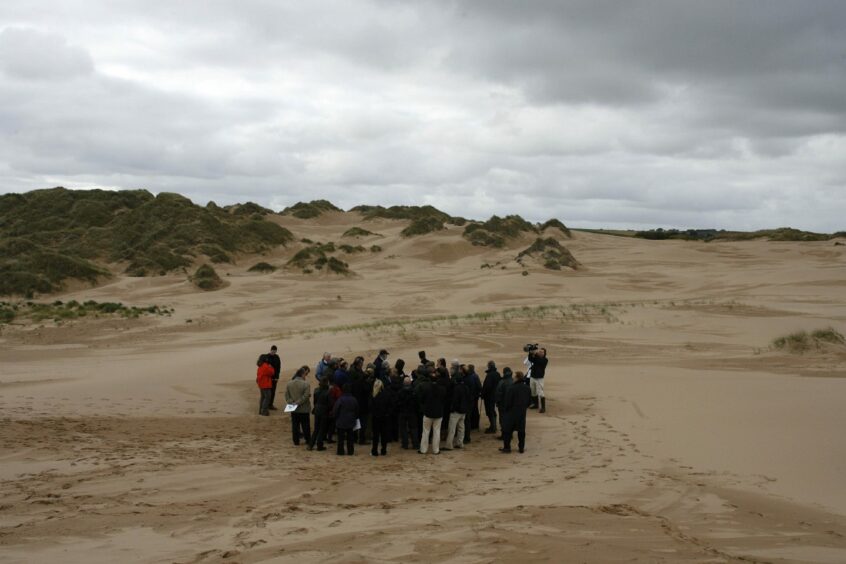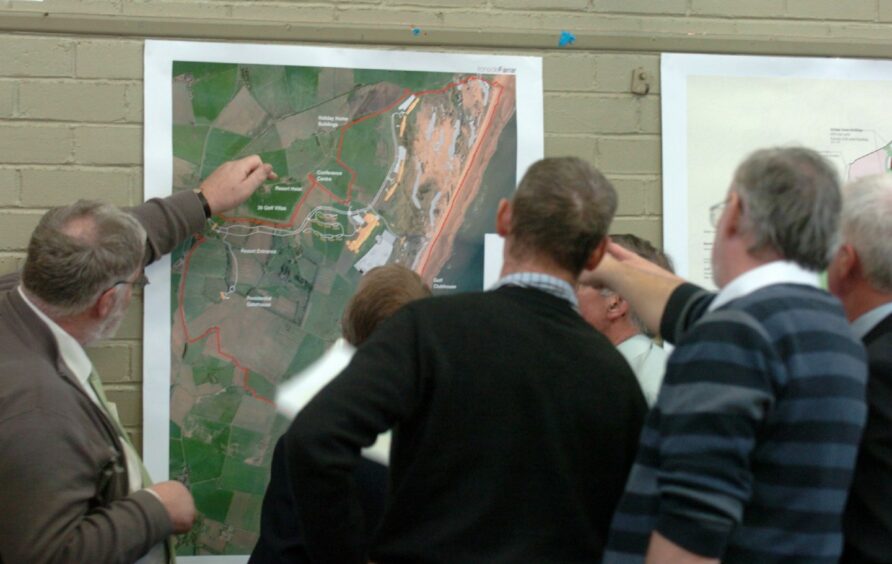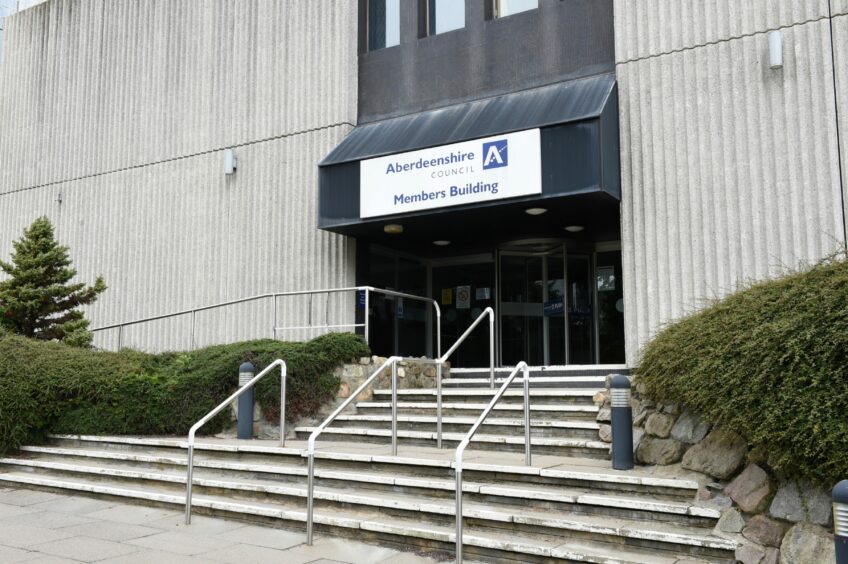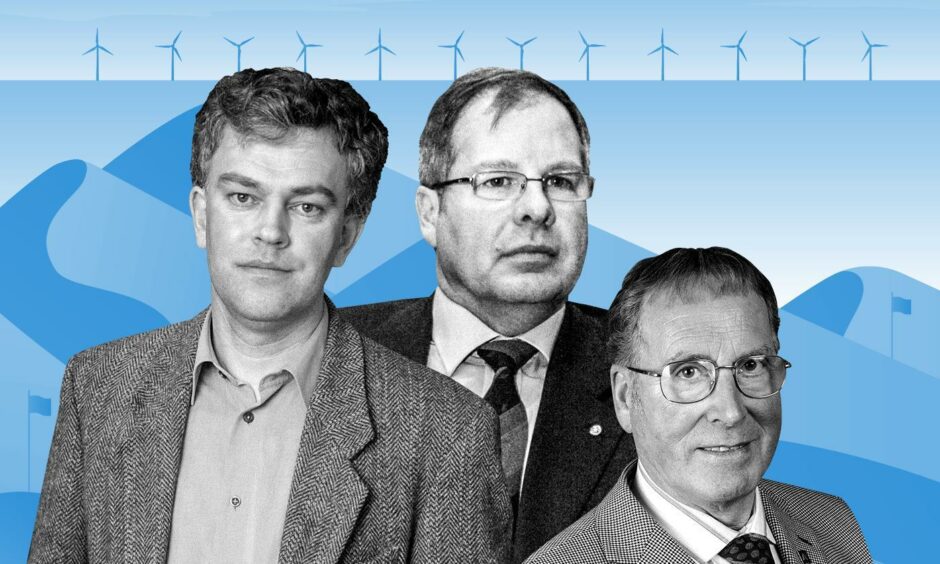
In part one, we heard how Donald Trump tabled an audacious bid to build the world’s best golf resort in the north-east. As politicians got involved, there were rows over whether the project was a done deal – and that was before the planning application was even made.
Here, in part two, we look at how tension built across the region in the run up to a key vote – and how sparks flew once the decision was made.

Trump International finally applied to the council for planning permission in late November 2006.
However, vital documents were not sent until March 2007. This meant planners could not write a report assessing the merits of the project until after then.
The consultation began in earnest later in 2007 and then it was time for politicians to make a decision whether the golf resort should be built.
Policy meant local councillors got first say.
A baptism of fire for the Aberdeenshire councillors

The application went before Formartine Area Committee at Balmedie Primary School in September 2007.
Aware of the massive public interest, the committee members deferred their decision for two months.
That gave them time for a site visit – on September 27, 2007 – so councillors could see the area and quiz experts.
It also gave them time to hold a public hearing, allowing everyone to have their say.
One of those attending was another of the 14 decision-making councillors, Jim Gifford.
Gifford, who had only been elected four months prior, said: “We had an absolute baptism of fire.
“We were brand new councillors thrown into it and had a whole day of a site visit at Menie, taken round in four-wheel drives.”
Another of the 14 decision-making councillors – and another rookie councillor – was Ian Mollison, who said: “I felt somewhat overwhelmed by it all.”
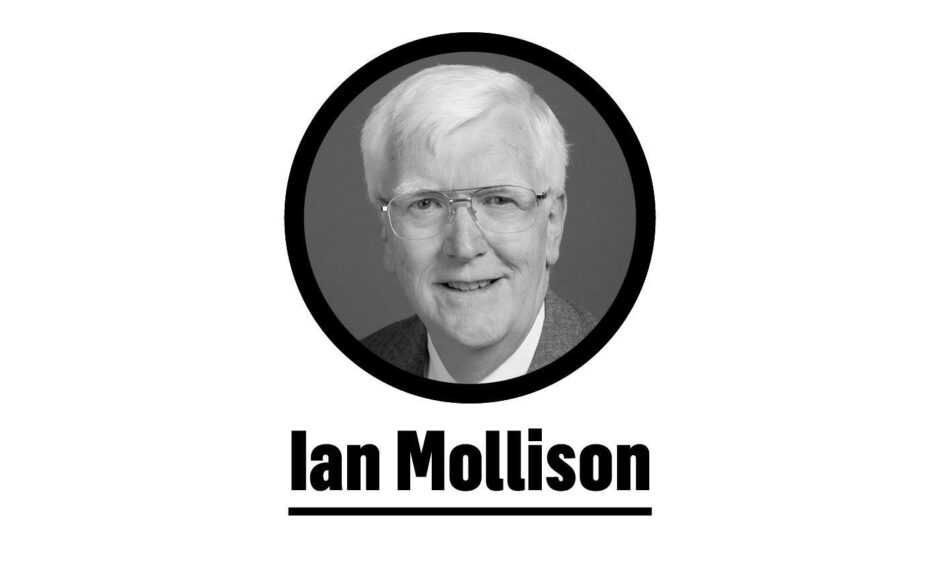
Another of the councillors tasked with making a decision on the resort was Fiona McRae, who said: “We were bombarded with emails – some hateful. It was stressful. People were accusing us of bribery.”
Things got heated on the site visit when pro-business councillors John Cox and Albert Howie argued with pro-environment councillor Martin Ford.
Howie said: “Ford was talking about insects in tall grass but there were no creepy crawlies anywhere.
“Some of the anti-capitalist people don’t like Donald Trump full stop.”
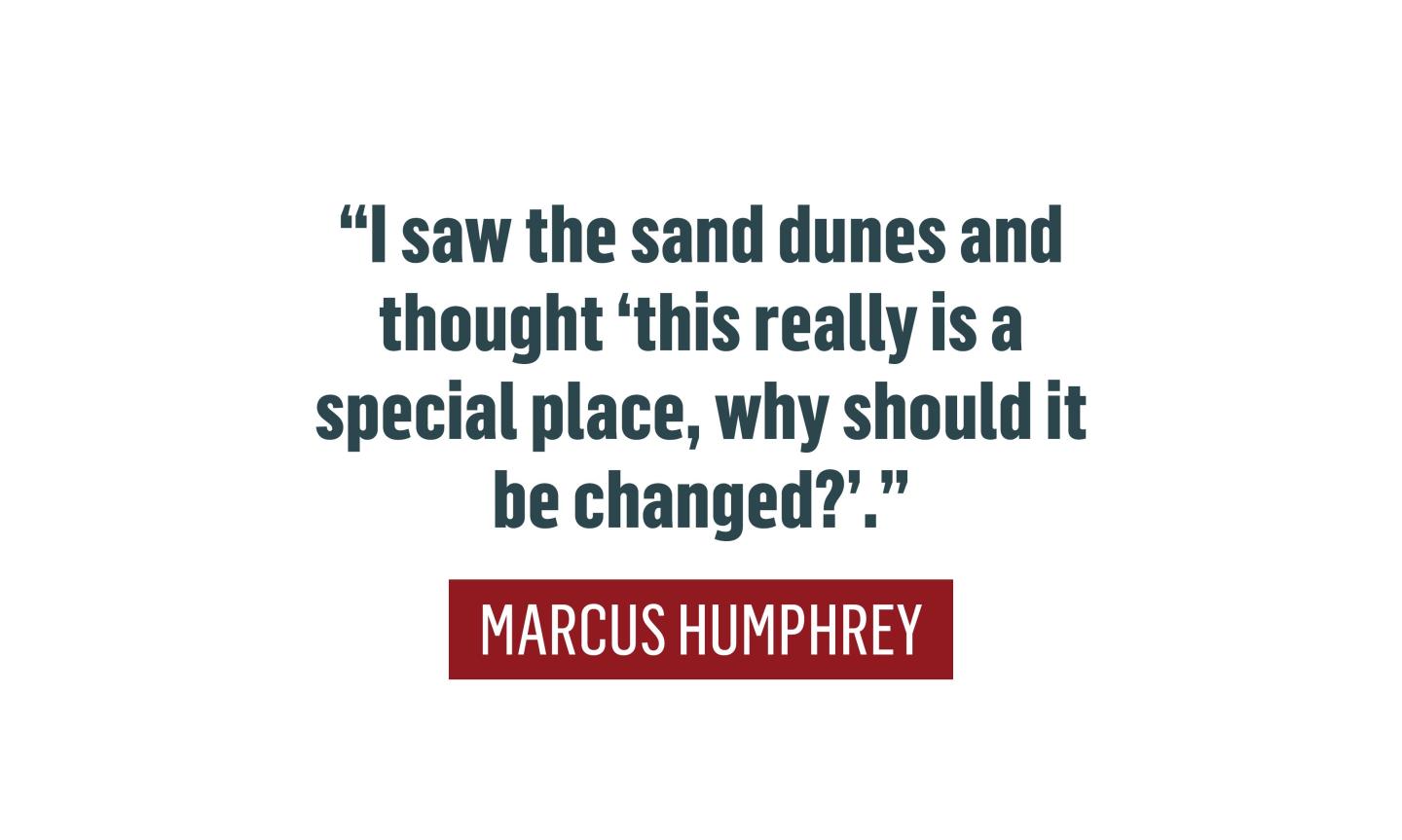
Albert Howie also questioned whether Debra Storr and Martin Ford should have been allowed an opinion, as they were not born in the north-east.
Howie said: “What I didn’t like was some councillors against Trump were not local people – inaboutcomers we call them.
“I’m not anti-English. Some of my best friends are English but it didn’t seem fair them commenting on affairs here.
“This definitely included Martin Ford and Debra Storr.”
He then corrected himself. “It may be shouldn’t be taken into account because they have made their home up here.”
John Cox, who was a big supporter of the project, said: “The biggest opposer within the council Martin Ford trundled along claiming all the wildlife would be extinct and we were standing there on the sand dunes saying ‘what wildlife?’.
“Ford said ‘it’s all under the sand’ and I said ‘well the sand is still going to be there’.
“He wanted to get his point across in a bizarre way.”
Marcus Humphrey said: “I saw the sand dunes and thought ‘this really is a special place, why should it be changed?’.”
Meanwhile, Paul Johnston, another of the decision-making councillors, had concerns that Aberdeenshire Council chief executive Alan Campbell had already decided the project should be approved.
Johnston said: “I had a conversation on the site visit which kind of triggered that issue. Campbell asked questions which were leading.
“It was pretty clear which way he wanted the vote to go.”
We contacted Alan Campbell for this series. He did not wish to take part.
However, Aberdeenshire Council said all policies were followed.
Recalling the site visit, Jim Gifford added: “There was a break for a cup of tea in Balmedie afterwards, then a public meeting in the primary school with about 120-odd people there.
“It was just incredible. We had Sky News – you name it, they were there.
“The public meeting started at 5pm and we were still there after midnight.
“It would have gone on for longer but some speakers had gone home.”
Fiona McRae said she tried to sit at the back.
She added: “It got quite heated. Anyone who knew you were a decision maker – you were their captive audience.”
Martin Ford said: “Presentations varied from somebody standing up telling us what they thought to a promotional video from the applicants.
“If you hadn’t already realised it from newspapers and public conversations down the pub, you certainly knew by the public hearing that very large numbers of people felt very strongly indeed either for or against, as though they had a personal stake in it.”
Gifford described the promotional video as “the most schmaltzy, un-Scottish thing and very much American.”
He added: “You could see the whole room going ‘oh my God, what the hell is this?’”
George Sorial took exception to that observation.
He said: “It’s kind of a ridiculous comment to make.
“The individuals who put together that presentation – most of them were locals.
“In this day and age, let’s get beyond the whole America vs Scotland thing.”
The first Aberdeenshire council vote

Formartine Area Committee members would have another seven weeks to consider the raft of documents associated with the application before meeting to discuss the issue on November 20, 2007.
The meeting played out like this:
There were three options:
1. Grant permission for construction of the golf resort.
2. Refuse permission.
3. Defer until later.
Anne Robertson (now Stirling) moved a motion to grant permission.
Debra Storr moved an amendment to refuse.
Paul Johnston moved an amendment to part refuse, part defer (refusing the 500 homes aspect of the application and deferring the rest of it).
In a primary vote, the amendments went up against each other, and ‘part refuse and part defer’ won 7-4.
That option then went through to a final vote against ‘grant’.
‘Grant’ won 7-4.
Sandy Duncan raised some eyebrows by voting both to refuse and grant permission.
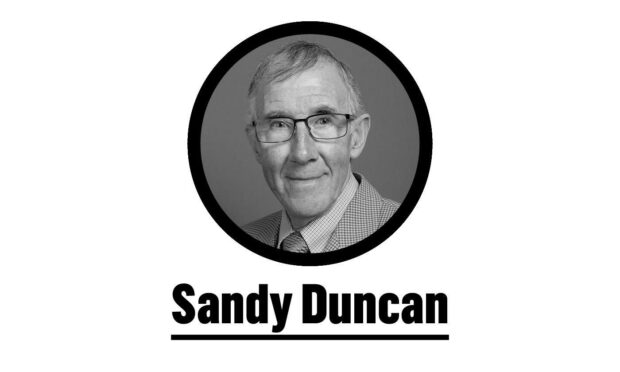
Debra Storr speculated on why he voted both for and against the project at the same meeting.
She said: “It’s quite conceivable that he voted in favour of the application kind of by mistake.”
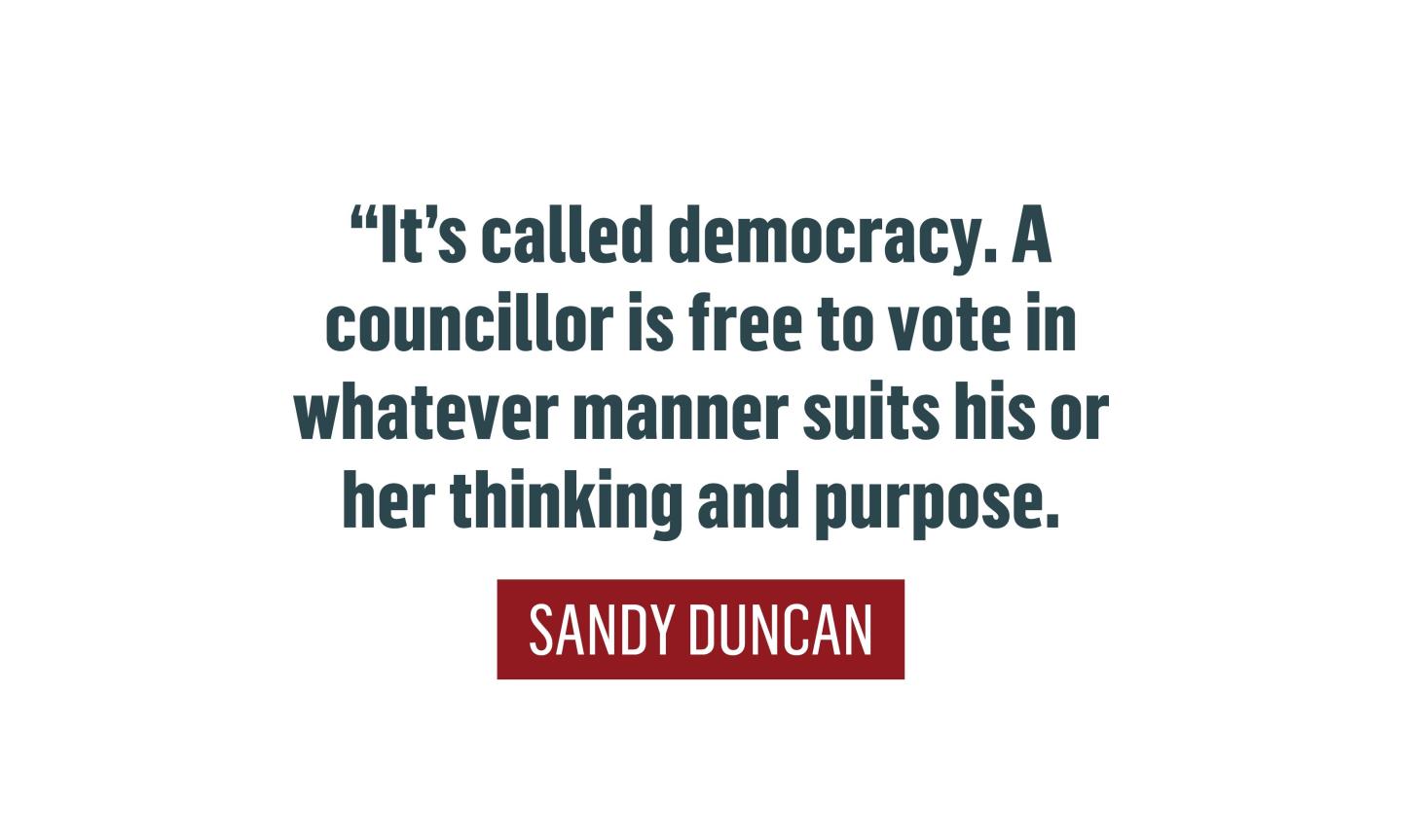
However, Duncan said he initially voted against the resort because it was the quickest way of getting to the deciding vote.
He said: “I knew the first vote wasn’t the decider for the application and felt the sooner we got to the nitty gritty the better.
“I have frequently formally seconded a motion, or amendment, over the years, and then voted the opposite way in the final vote.
“It’s called democracy. A councillor is free to vote in whatever manner suits his or her thinking and purpose.”
There were again rumblings of political interference – this time involving Councillor Anne Robertson, now Stirling.
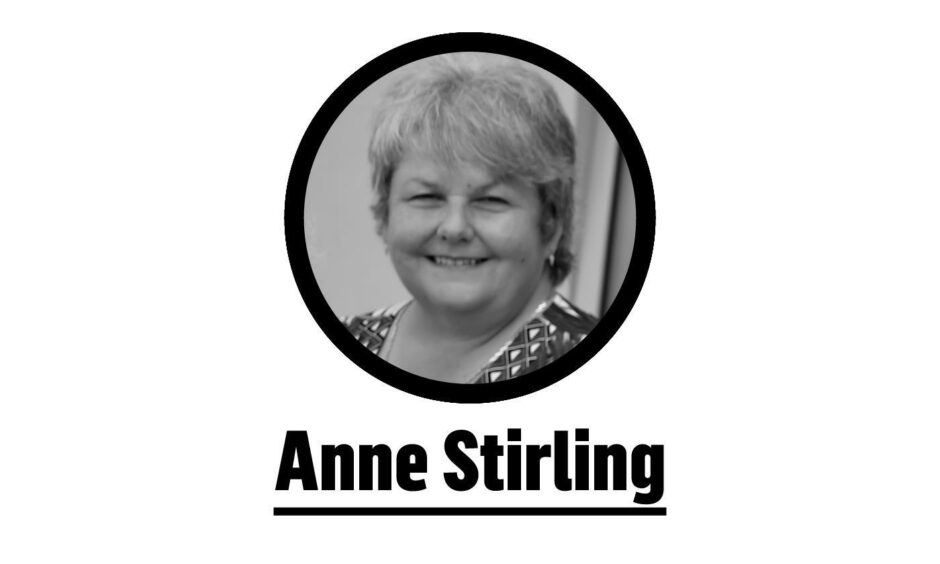
At the time she was leader of the council and leader of the Lib Dem group.
The area committee meeting was chaired by another Lib Dem, John Loveday, who allowed Stirling to talk first.
However, he was surprised when she immediately tabled the motion, urging her committee colleagues to grant the application before a debate.
Loveday said: “I told Anne ‘it’s rather premature, let’s have a discussion first.’
“She was basically saying she’d made her own mind up already and, whatever other people were going to discuss, it didn’t matter.”
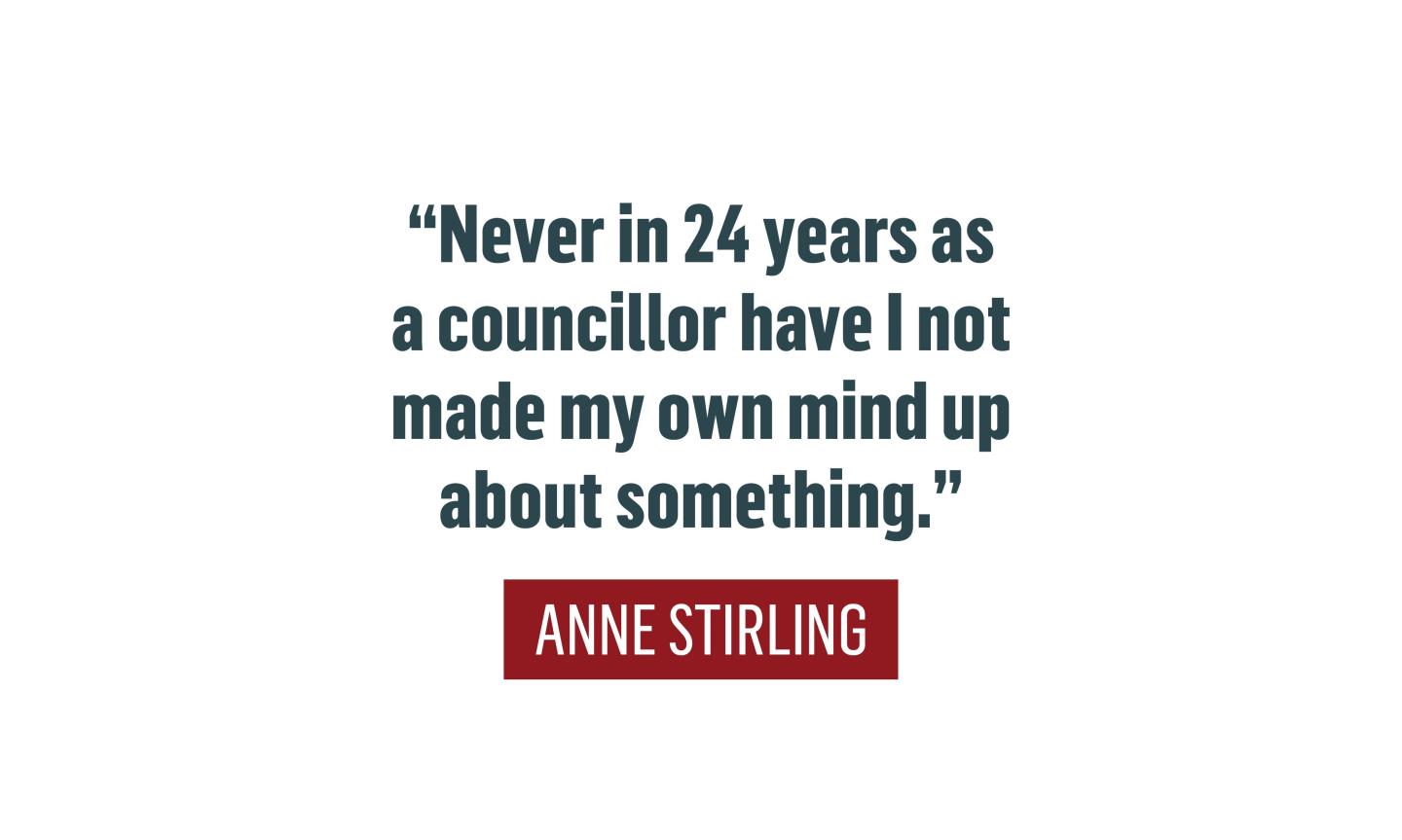
Anne Stirling told us: “That is an absolute misrepresentation of where I would have come from.
“I don’t recall ever saying that it doesn’t matter what other people think.
“(Tabling a motion) does not stop a debate in a committee or putting other motions on the table.
“I take all information into account before reaching any decision.”
Loveday said he understood why Stirling – and any council leader – would want to grant such a project as it would make the area seem development friendly.
He added: “If you’re in that position, as the leader you would be wanting it granted.”
Johnston agreed. He said: “Stirling knew which way (Aberdeenshire Council chief executive Alan) Campbell would have been thinking about it.”
This was strongly denied by Stirling, who said: “Never in 24 years as a councillor have I not made my own mind up about something.
“That’s not how it works. Any council leader will work closely with the chief executive but I make up my own mind.”
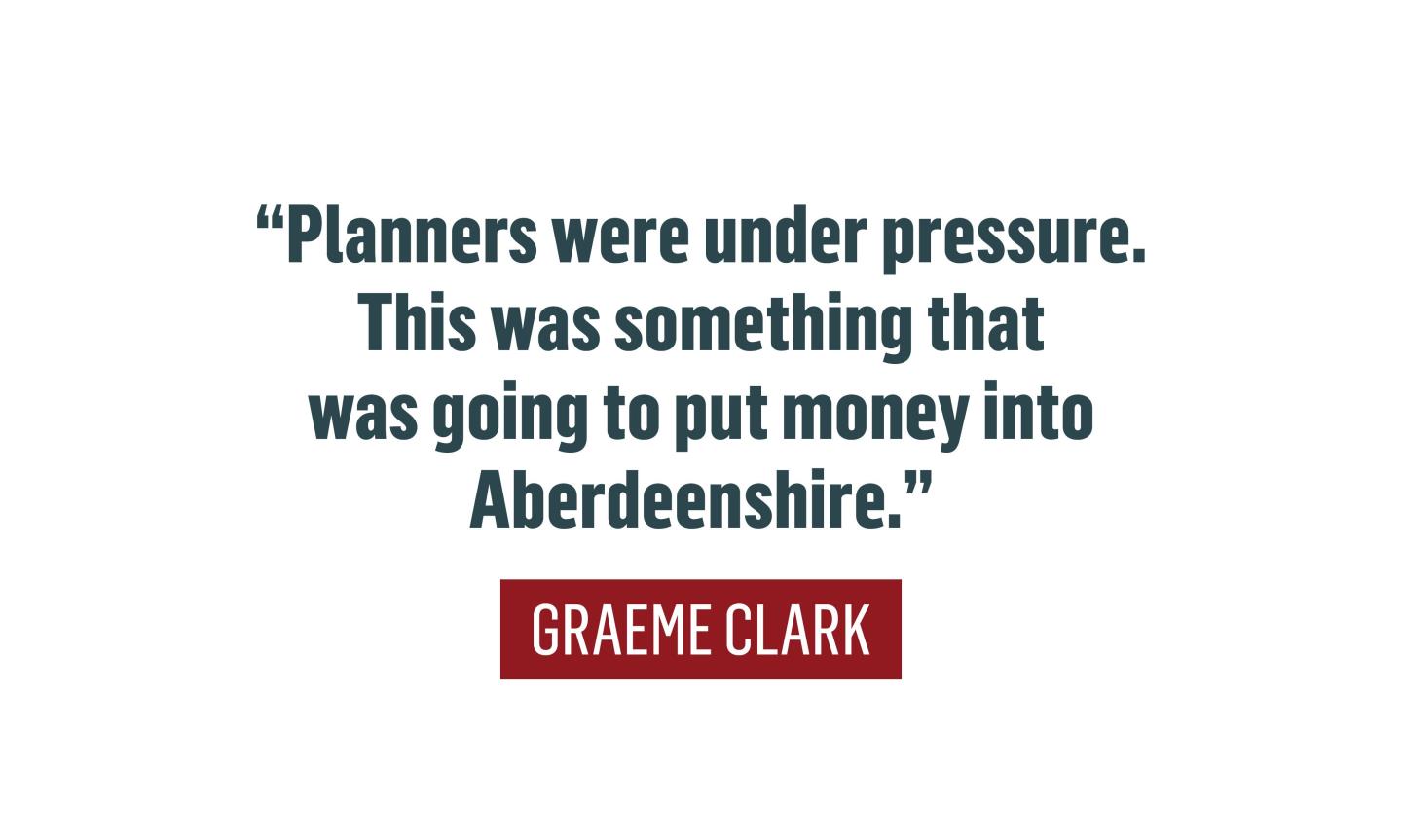
Council under pressure
Several councillors alleged civil servants had been lent on by politicians.
The planner’s report stated the resort would breach policy – but recommended councillors approve it anyway.
Graeme Clark, who was another councillor tasked with making a decision about the golf resort, said: “Planners were under pressure. This was something that was going to put money into Aberdeenshire.
“They knew ‘no, this doesn’t meet with policy’ but we can recommend it for approval due to the advantages for Aberdeenshire.”
Debra Storr, whose professional background means she has worked with thousands of planning applications in her career, said: “I have never seen a committee report with so many adjectives such as ‘iconic development’. It beggars belief.
“It read like somebody had been through it, added piles of good adjectives and deleted any bad adjectives.”
An Aberdeenshire Council spokesman described this allegation as “a matter of opinion”.
We have analysed the 80-page planner’s report and found seven uses of the word ‘iconic’.
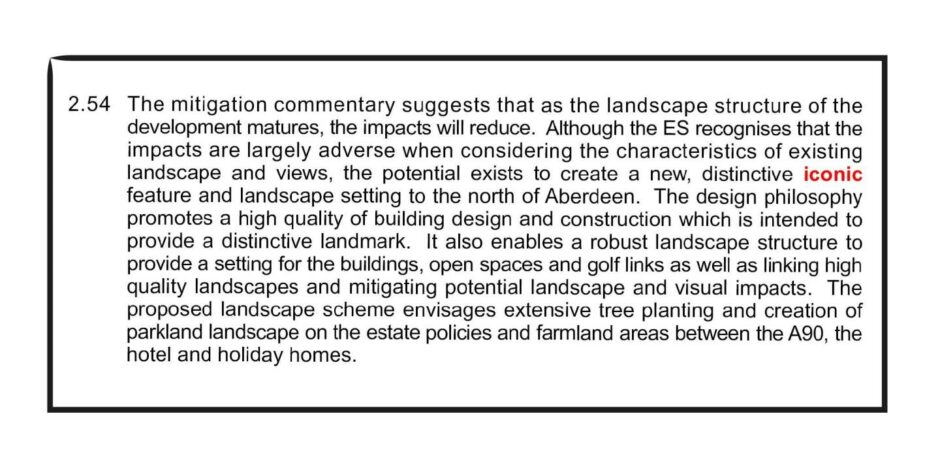
All seven mentions relate to planning terminology rather than the planner giving her own opinion.
Planning policy dictates that, if a developer is going to build something particular big or prominent, they should use the highest-quality materials and design available so it becomes iconic – widely known and distinctive – rather than a blot on the landscape.
Our assessment concluded the report contained 49 positive and 25 negative references about the proposal.

That is not unusual in a document designed to assess the merits of a proposed development, particularly when the author’s objective conclusion is that it should be approved.

Perhaps the only illogical part of the report concerns housing. The 500 homes were proposed for an area not suitable for housing, according to the council’s development plan.
But the planner argued that, without the houses, there would be no golf resort, so the area would miss out on a £1b windfall.
Her report said: “The (council’s) development plan could not have foreseen this proposal or its scale and the economic impacts outweigh…concerns because of this.”

She added that going against the development plan in this case could not be seen as a precedent because of the “extremely rare circumstances”.
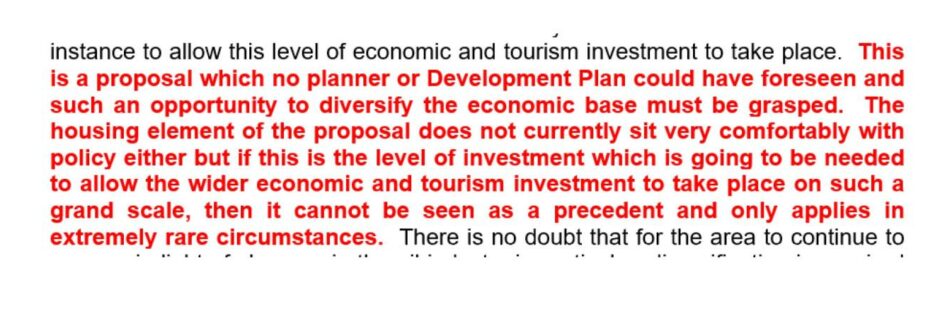
Storr said she believed politicians had instructed the planner to change the report and added: “The planners tried to do a decent job on this but they were actually being issued with instructions from higher up.
“There was a big political environment running quite broad and quite deep. This was political at a Scottish level.
“There are politicians and planners quite senior in the Scottish Government who recognise this was a mess.
“They saw it as a big mistake in the way it was ultimately handled. The consequences have been incredibly negative overall.”
An Aberdeenshire Council spokesman said this is an opinion and added: “All relevant policies and procedures were followed at the time.”
John Loveday said that, looking back, he regrets not raising more concerns at the time about the handling of the application.
He added: “I probably could have spoken up more about the pre-application discussions.
“There was so much discussion between the applicant and officials before the application went in.
“The rules changed as a result. You now have to record the fact there were meetings about planning applications long before they were put in.”
He added that, though he had concerns about impartiality, “it wasn’t corrupt in any way.”
Jim Gifford said: “We dealt with this the same as a loft extension. That clearly didn’t work so there was a change in the process (by which planning applications were handled).”
In practise the area committee’s decision counted for little.
Had it refused the application – that would have been the end of the road for the golf resort, save for any formal appeal from Trump.
But an area committee approval merely meant its view had to be considered by the Infrastructure Services Committee (ISC) – the decision-making body – which met just over a week later.
Martin Ford, who was ISC chairman said: “We got the area committee’s view expressed… But it was not an end point and was never going to be an end point.”
The second council vote
The big meeting was to take place on November 29, 2007 – and it was an affair that would send shockwaves through the council and the region.
The council did everything to ensure the ISC meeting ran smoothly.
The public hearing and written consultation process meant there was no need for the public to speak at the ISC meeting, reducing the prospect of a shouting match.
Still, there were around 40 people in the public gallery, including journalists, project cheerleader Neil Hobday and Trump’s right-hand man George Sorial and several people there for other items on the agenda.
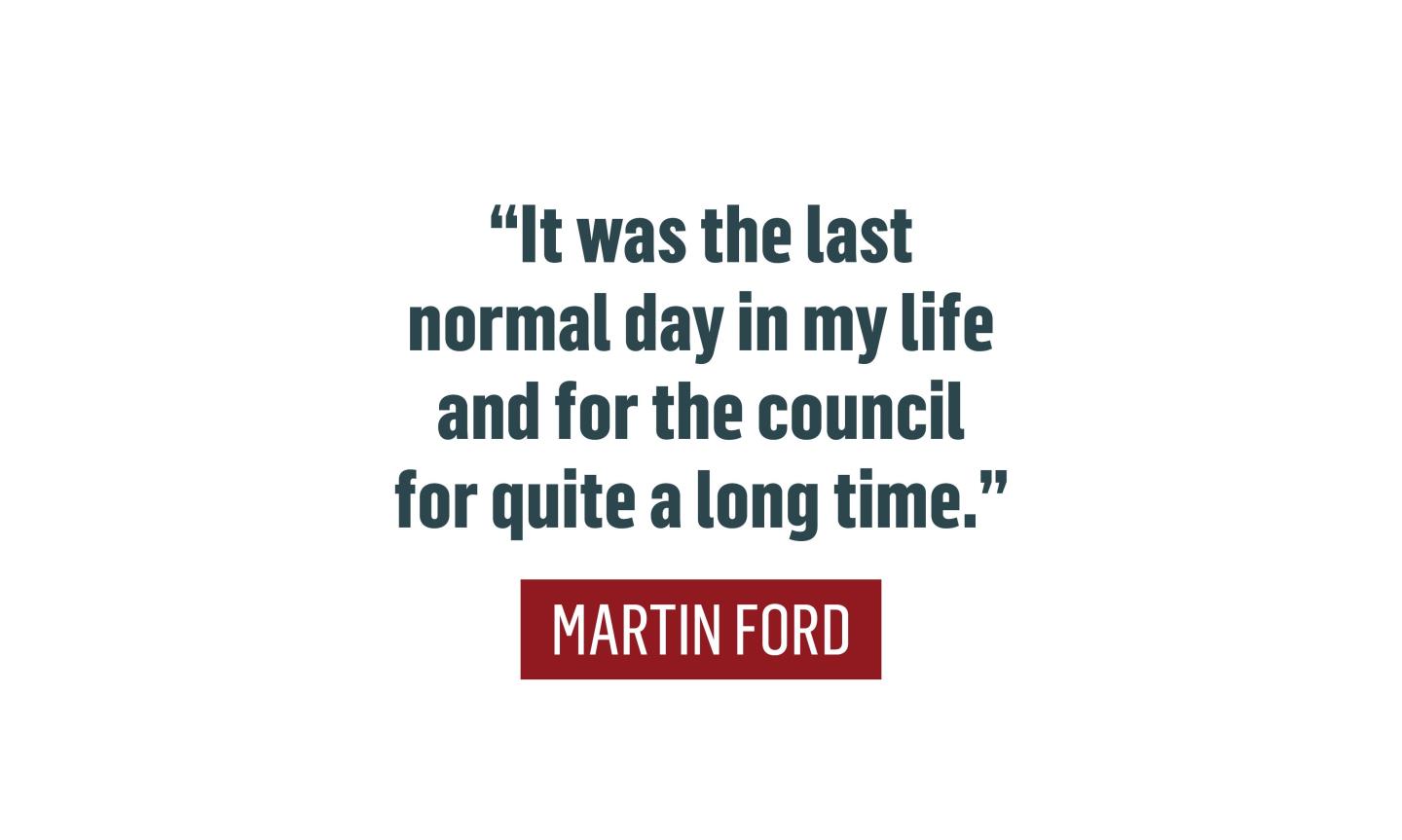
It started at 10.15am in Committee Room 5 at Woodhill House – and would end in a way that would turn the life of chairman Martin Ford upside down.
Ford said: “It was the last normal day in my life and for the council for quite a long time.”
That morning he cycled from home to the council headquarters early doors and read the agenda papers before hosting a pre-meeting of ISC members.
At those pre-meetings, protocol is discussed – but discussion of planning applications is banned.
Ford said: “I may have reminded people ‘look, there’s going to be folk here today but you just treat this like a planning application’.”
But the pressure was on.
All told, almost 2,000 people had formally supported the application and there were almost as many objections.
2,999 letters of representation were received.
1,951 of them were in support…
He added: “We knew at minimum your decision will have upset or angered 1,500 people.
“Planning is a bloodsport with full audience participation.”
Once the actual ISC meeting started, Ford opened the meeting by mentioning protocol.
He told us: “This was for the benefit of members of the public who, in some cases, were suspicious of what the council was doing because there clearly was suspicion of prejudgement.
“I said ‘where an applicant’s mother is born is not a material planning consideration’.”
ISC committee member Fiona McRae said: “People who knew Trump warned us the golf resort wouldn’t come to fruition – but that’s hearsay.
“All we had to judge on was what was presented to us in council documents.”
The first seven agenda items included whether a house in Aberchirder, and sheltered housing in Banff, should be built.
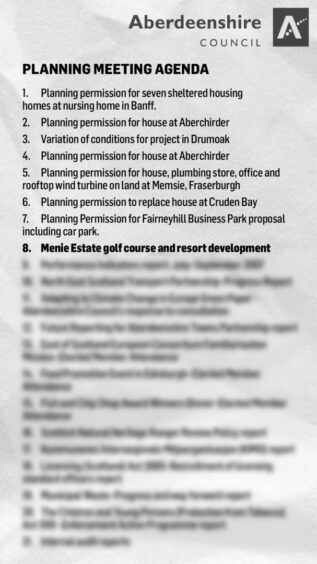
“None of those items turned my life upside down,” said Ford.
And then it was time for the headline act.
There were 14 committee members – three of whom had voted at the area committee a week earlier.
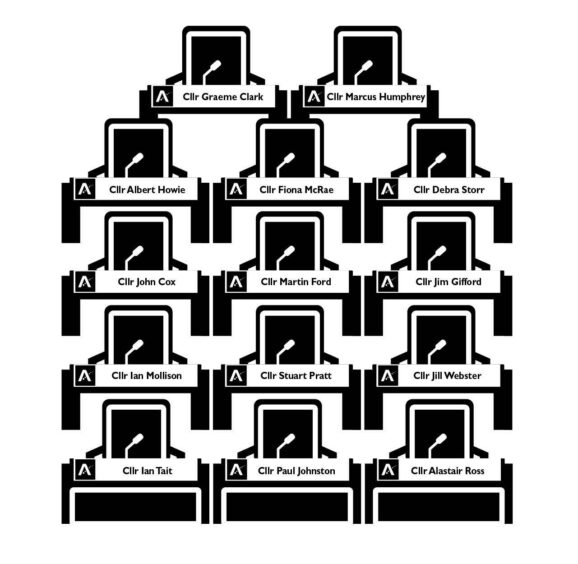
At that area committee meeting, Storr and Johnston had voted against the golf resort and Gifford voted to defer the decision.
But they could conceivably change their minds – and they were just three of 14 councillors who the decision rested upon.
Nobody could predict how the 11 others would vote – so it was all up for grabs.
The council’s planning director Christine Gore introduced the item and councillors began discussion.
Formartine Area Manager Keith Newton was among the civil servants there.
He said: “It was a very interesting time to be involved. It was a major development that attracted a lot of attention.
“My main remit was to ensure the process was followed the way it should be – and everything was done that way.”
Grant, defer or reject the Trump golf course?
Allegations of plots were everywhere.
ISC chairman Martin Ford removed a rule so councillors could talk for as long as they like, so nobody could later accuse him or anyone else of silencing people.
Ford then gave the floor to another of the 14 decision-making councillors, Alastair Ross.
Ross tabled a motion to reject the resort.
This meant the ‘reject’ option only had to win one vote rather than two – and also that Ross would have the last word in the debate.
Some were fuming.
John Cox, who wanted the resort to go ahead, said: “Ford should have said ‘okay, I’ll take the motion when everyone has had a chance to speak.
“He took the first hand that went up – and we all know how close he worked with Ross.
“It’s a bizarre situation where a chairman says ‘I’m not taking any motions (because everyone needs a chance to speak)’ and then takes a motion. He contradicted himself.”
Albert Howie, who was also pro development, said: “It did look as though it was engineered.”
However, others claimed those views were overly conspiratorial.
Fiona McRae said: “I doubt (there was a fix by Ford and Ross). If that were true, it would be genius.”
The ‘reject’ motion was seconded by Debra Storr.
She told us she spoke with Ross before the meeting about the motion.
Storr said: “I had a discussion with Alastair – who is going to propose it and who is going to second it?
“(I was) seen as a more divisive figure than Alastair, so Alastair proposing it made sense.
“You’re not supposed to go into these meetings having absolutely made up your mind but (with me having voted to reject at the area committee) and good people like Alastair sitting through the Balmedie public meeting, you kind of get a flavour of who is jumping which way.”
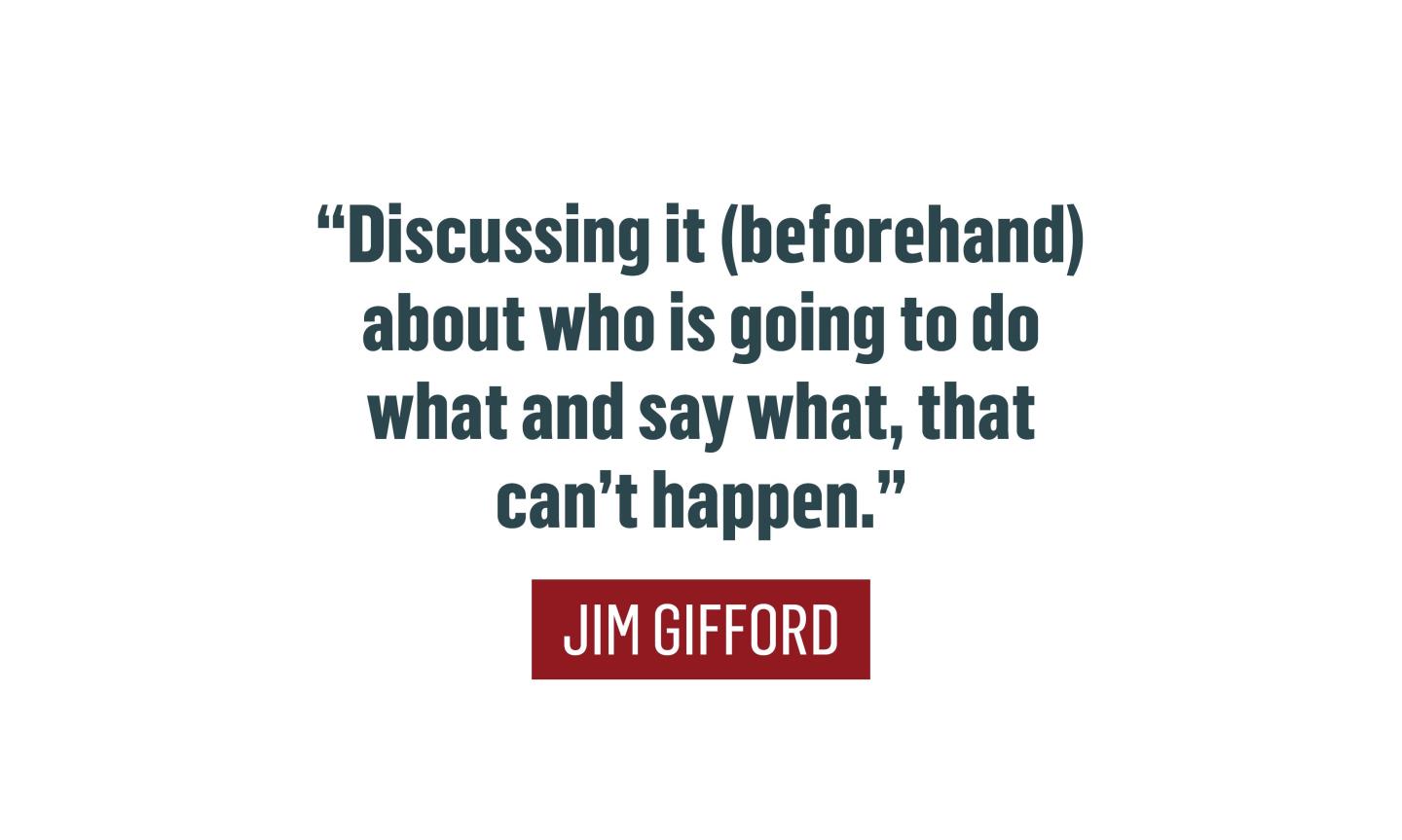
Reacting to Storr’s statement today, Jim Gifford said: “They (Storr and Ross) should have been disbarred from going to the meeting. That’s an absolute no-no.
“Discussing it (beforehand) about who is going to do what and say what, that can’t happen.”
However, Storr suggested she did not break any rules because all the evidence had been presented to councillors by the time the area committee meeting was over.
Storr said: “There was no new information between the area committee and the ISC, so Jim Gifford is wrong.”
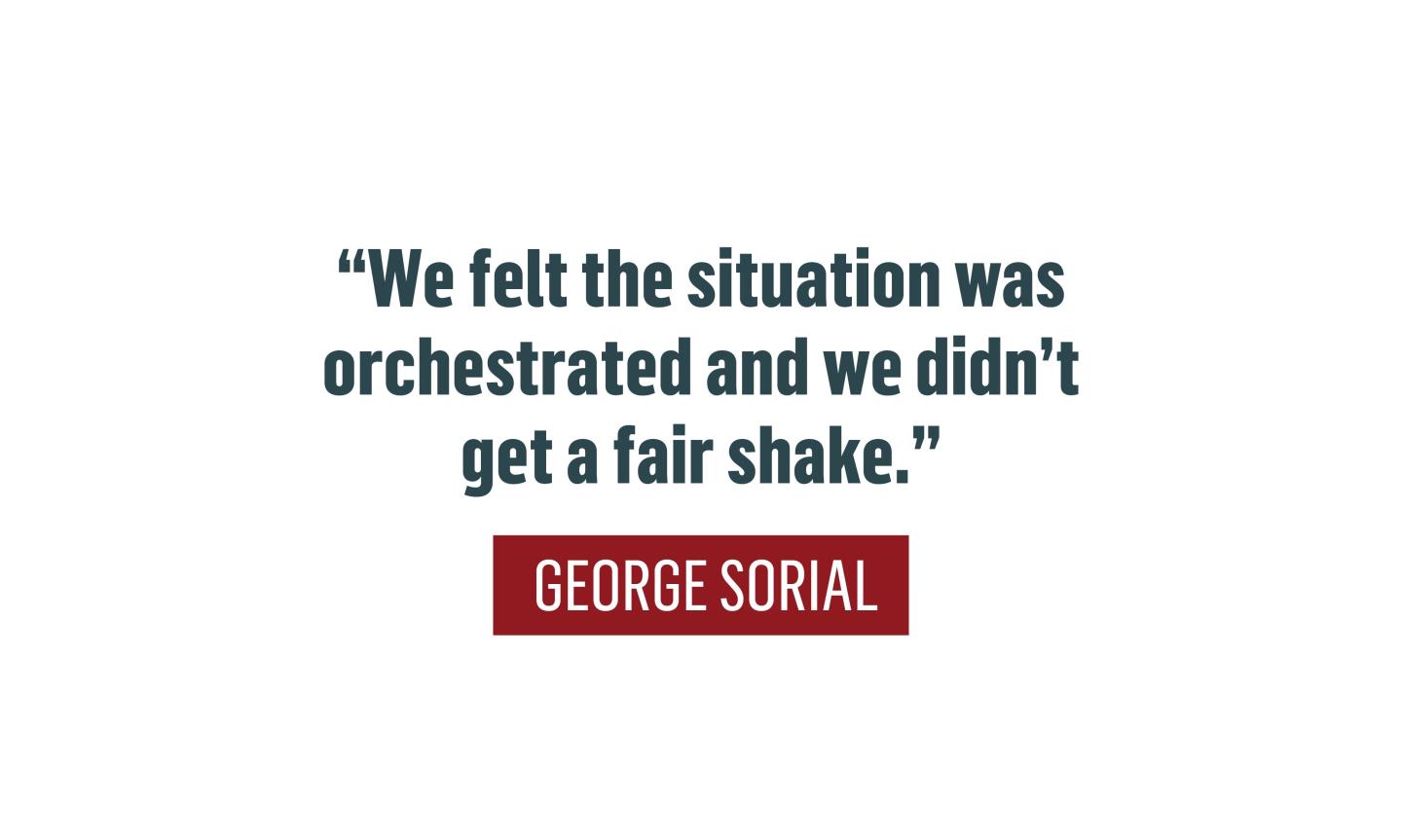
Two amendments were tabled – one from Cox to grant permission and one from Johnston to defer.
That meant ‘grant’ and ‘defer’ would compete in a preliminary vote.
‘Defer’ won 9-5, meaning ‘defer’ and ‘refuse’ would do battle in the final vote.
John Cox’s blood was boiling, as his ‘grant’ amendment lost the first vote and so wouldn’t stand a chance of winning outright.
He blamed Martin Ford, accusing him of “engineering” the vote.
Cox said: “Everyone knew what Ford’s position was and he made it quite clear by not allowing open debate.
“It was quite clear it wasn’t going to matter what was said that day.”
Neil Hobday, who was in the public gallery, told us: “I got the sense by body language and the looks around the room that a deal had been done outside. That was my sense of it.
“I remember our team kind of looking at each other with a sense of ‘something has happened here’.”
Sat next to him was George Sorial, who told us: “We felt the situation was orchestrated and we didn’t get a fair shake.
“About halfway, during that hearing, I didn’t like what I was seeing.”
Ford retorted: “A cynic could argue all sorts of things about the whole day but the reality is the council’s procedure was perfectly clear and I followed it as committee chair.
“The obligation of the chair is to take councillors on the order they catch his or her eye.
“The first proposal to be made was from Alastair Ross. The debate went on.
“Twelve of the 14 committee members spoke including me. I let the other 11 say their piece first before I spoke. Debate took two-and-a-half hours.”
Jim Gifford defended Ford. “Martin was an absolute stickler for the rules. He had some strange views on things but plays things absolutely straight.”
However, Gifford accused Ford of “operating a very slick double act” with another councillor and fellow Lib Dem, Paul Johnston.
Gifford questioned why Johnston tabled the ‘defer’ option – then voted against it, describing it as a “clever manoeuvre” designed to get other ISC members “thinking about the direction of travel”.
Gifford said: “Johnston had done it many times. I don’t think there’s any doubt about (it being a ploy).”
Johnston said there was no conspiracy and – far from being a “double act” with Ford, he claimed the pair hadn’t actually spoken civilly for five years as they did not get on.
Johnston added: “Gifford is being disingenuous thinking there was some kind of conspiracy.”
Johnston said he tabled the ‘defer’ motion so all options could be explored and it wouldn’t be inevitable that it would come down to ‘take it or leave it’.
The councillors had been working since 9am and so the meeting broke off for a lunch break at 12.45pm.
Ford said: “It was not fine dining. I think the break was 45 minutes.”
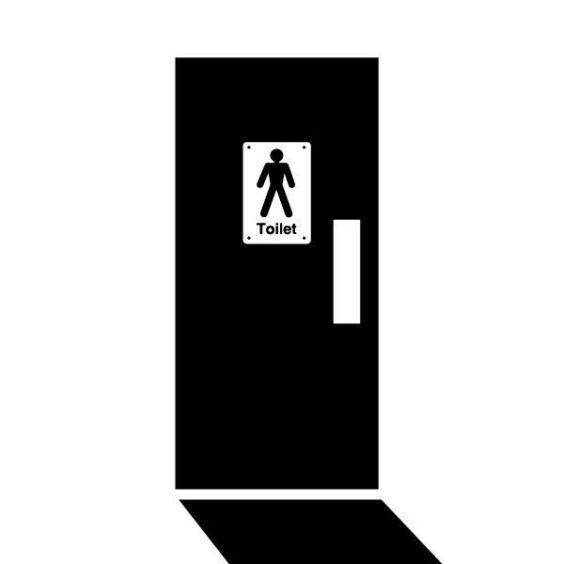
He added: “I had to nip out to the gents. While I was there, George Sorial came in and he said ‘you’re moderating the meeting very well’.
“It was only hours later that he was declaring I wasn’t fit to hold public office, but that’s life.”
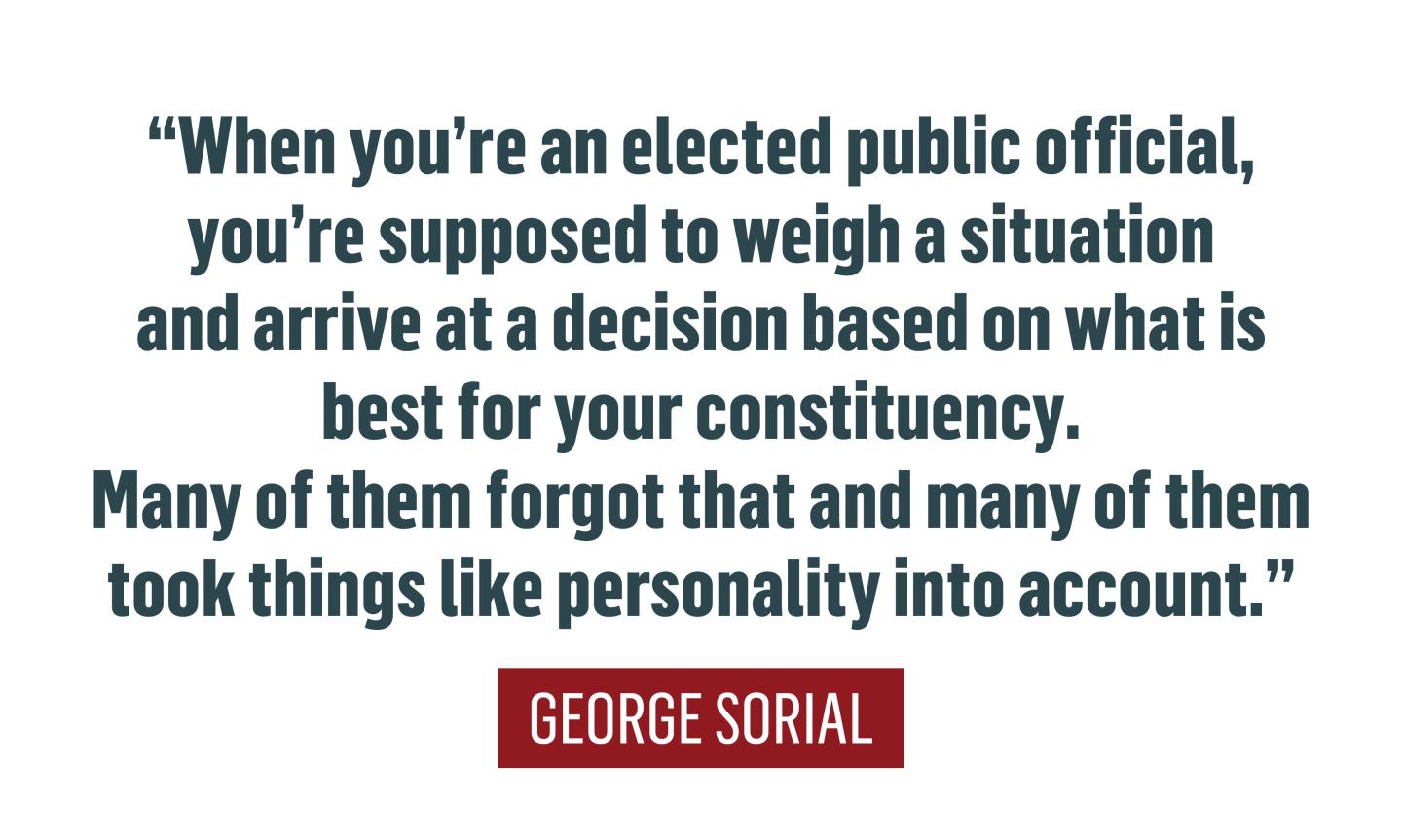
Sorial told us: “I think his decision was unfit, not him.
“When you’re an elected public official, you’re supposed to weigh a situation and arrive at a decision based on what is best for your constituency.
“Many of them forgot that and many of them took things like personality into account.”
The deciding vote
The meeting resumed and, as the final vote loomed, councillors heard arguments for deferring the decision.
Debra Storr said: “The only realistic options were to try to cut it down to a 250-bedroom hotel and a golf course off the SSSI, which could have been accommodated within policy.”
Graeme Clark also wanted reassurances over infrastructure for the proposed homes.
He said: “If they built 500 houses, they would swamp schools, so I was looking for something from Trump International where they would give money to the local school, or whatever. Nothing like that was coming.”
Some councillors believed ‘compromise’ is a word Trump doesn’t understand.
Ford said: “The applicant had been shouting from the rooftop for months saying: ‘Give me the whole thing or I walk’.
“It seemed to me utterly pointless to defer to negotiate with someone who said he will not negotiate.
“My best guess is we would have been back at (another) ISC (meeting) in the new year with no changes and a huge public campaign – not least run by the local newspapers – to pressure the committee into agreeing to what we had already said was unacceptable.”
Clark agreed. He said: “The applicant could come back with the changes we needed but obviously Trump International didn’t want to do that.”
It came down to a final vote between ‘reject’ and ‘defer’.
First to cast his vote was Martin Ford as chairman, before the other councillors voted in alphabetical order.
Marcus Humphrey said he decided to vote against the plan immediately after hearing Ford do the same.
He said: “Maybe in retrospect it was a little bit misguided, but my feeling was that, as deputy chairman, it would send out the wrong signal if the deputy didn’t back his chairman.
“Nobody knew how the vote was going to go until the very last vote was counted.”
As the clerk tallied the votes, tension grew.
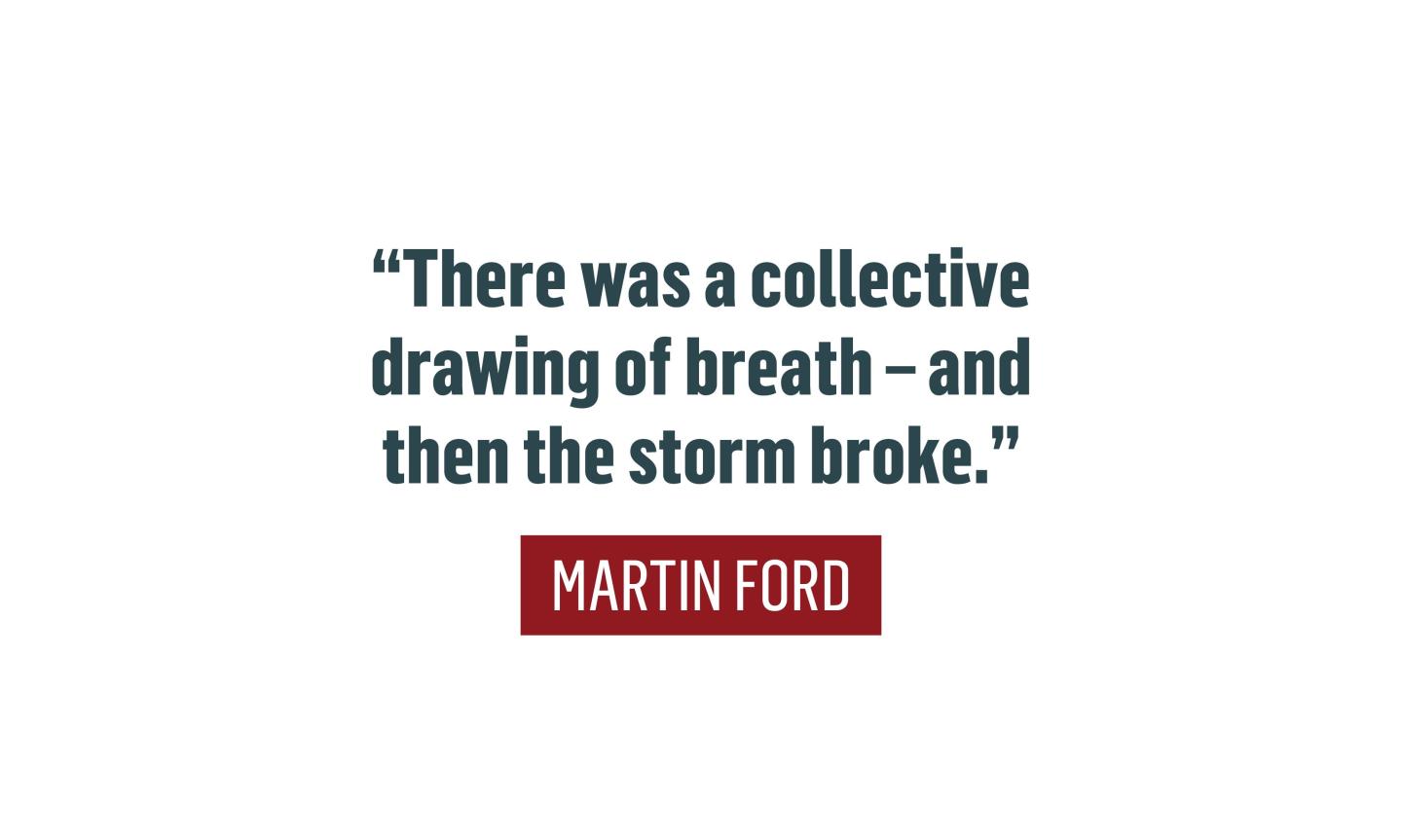
Ford said: “It would have been perfectly obvious to anybody listening to the debate it was going to be a close vote.
“Since two had not expressed a view, it could be a 7-7 tie or a 9-5 split.”
In the end, it was a 7-7 split.
Ford added: “I didn’t know it was a tie until the committee clerk turned to me and said ‘it’s a tie, chair – you have the casting vote’.
“Without any hesitation at all I said ‘well, I’ll use my casting vote for Cllr Ross’s motion to refuse the application. The decision is refusal.’

“There was a collective drawing of breath – and then the storm broke.”
Credits
- Words by Dale Haslam
- Story design by Cheryl Livingstone
- Graphics and illustrations by Roddie Reid
- Data visualisations by Lesley-Anne Kelly
- Video trailer by Drew Farrell
